San Francisco's Water Supply System Used at Blaze
March 13--Firefighters battling the five-alarm Mission Bay blaze had to tap into San Francisco's rarely used emergency backup water supply when regular sources proved inadequate, officials said Wednesday.
The regular system of mains and hydrants could not provide enough water pressure for the 90 fire engines and trucks that after 5 p.m. Tuesday converged on the burning building, an apartment complex under construction at Fourth and China Basin streets, Fire Department officials said.
As a result, firefighters had to drag 5-inch-diameter hoses several blocks to tap into the city's network of high-pressure emergency fire hydrants, which are fed by gravity from a pair of tanks -- the Twin Peaks Reservoir, which holds 10.5 million gallons, and the Jones Street Tank on Nob Hill that contains 750,000 gallons.
The system, which dates to 1913, eventually gave firefighters enough water to control the blaze. But it required time to hook up; dragging the heavy-duty hoses to hydrants hundreds of yards away took more than 30 minutes, firefighters said.
In the meantime, crews used the existing supply to spray a "water curtain" to keep the fire from jumping to other buildings.
"The first step in the puzzle is to increase the domestic water supply," said Assistant Deputy Chief Ken Lombardi. "In a regular fire, if we have enough pressure at that point, game over, that's all we use."
There was only one high-pressure hydrant in the immediate area of the fire, however. Fire crews had to pick their way through other construction sites with their hoses and steel connectors needed to hook up to the more distant hydrants.
"That takes some time," said Mindy Talmadge, a Fire Department spokeswoman. "The first, main focus was protecting the surrounding structures. Once they got the (water pressure), they could deal with both situations at the same time."
Water flow from the backup system may have been slowed by the temporary absence of a third backup reservoir, a 500,000-gallon-capacity reservoir at Clayton Street and Twin Peaks Boulevard known as the Ashbury tank. It is being replaced, leaving the city with just the Twin Peaks and Jones reservoirs plus a pair of pumping stations that draw from San Francisco Bay.
Lombardi said the emergency system worked well once firefighters connected to it, and that it enabled firefighters to direct large amounts of water to put out the stubborn inferno.
"That was our biggest fire" in several years, Lombardi noted. "I thought it went off pretty flawlessly."
The system delivers water to lower-lying areas from the Twin Peaks Reservoir, which is 758 feet above sea level, and the Jones Street tank, which is at 369 feet. It was designed after the 1906 earthquake and fire by Michael O'Shaughnessy, the city engineer who also designed the Hetch Hetchy water system.
High-pressure hydrants have black, red or blue caps, distinguishing them from the smaller, all-white hydrants that deliver water from the regular supply. Not all the city is covered; there are few or no high-pressure hydrants in the Sunset, Richmond and Excelsior neighborhoods and around San Francisco State University.
A $400 million bond measure that would expand the system will be on the June ballot.
"After last night," Lombardi said, "you could see how important this would be to have this citywide."
Jaxon Van Derbeken is a San Francisco Chronicle staff writer. E-mail: [email protected]
Copyright 2014 - San Francisco Chronicle
